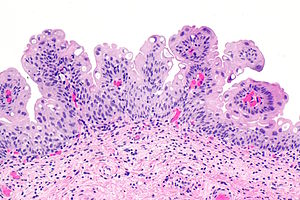Urothelial papilloma
Urothelial papilloma is a rare benign lesion of the urothelium.
| Urothelial papilloma | |
|---|---|
| Diagnosis in short | |
 Urothelial papilloma. H&E stain. | |
|
| |
| LM | papillary fronds with minimal branching or fusion, cytological and thickness of normal urothelium, no mitoses |
| LM DDx | low grade papillary urothelial carcinoma, PUNLMP |
| Site | urothelium - typically urinary bladder |
|
| |
| Prevalence | uncommon |
| Prognosis | benign |
| Clin. DDx | other papillary lesions |
General
Notes:
- If the person has a history of a low grade papillary urothelial carcinoma... it is likely a low grade papillary urothelial carcinoma.
- These cases are a consensus diagnosis, i.e. you show it to a colleague... if they agree you can call it.
Gross
- Exophytic lesion.
Microscopic
Features:[2]
- Papillary fronds.
- Minimal branching or fusion.
- Cytological features of normal urothelium.
- Normal urothelium approx. 2x the size of stromal lymphocytes.[3]
- No mitoses.
- Thickness < 7 cells.[citation needed]
DDx:
Images
See also
References
- ↑ 1.0 1.1 Al Bashir, S.; Yilmaz, A.; Gotto, G.; Trpkov, K. (Jan 2014). "Long term outcome of primary urothelial papilloma: a single institution cohort.". Pathology 46 (1): 37-40. doi:10.1097/PAT.0000000000000029. PMID 24300727.
- ↑ Humphrey, Peter A; Dehner, Louis P; Pfeifer, John D (2008). The Washington Manual of Surgical Pathology (1st ed.). Lippincott Williams & Wilkins. pp. 310. ISBN 978-0781765275.
- ↑ Zhou, Ming; Magi-Galluzzi, Cristina (2006). Genitourinary Pathology: A Volume in Foundations in Diagnostic Pathology Series (1st ed.). Churchill Livingstone. pp. 161. ISBN 978-0443066771.